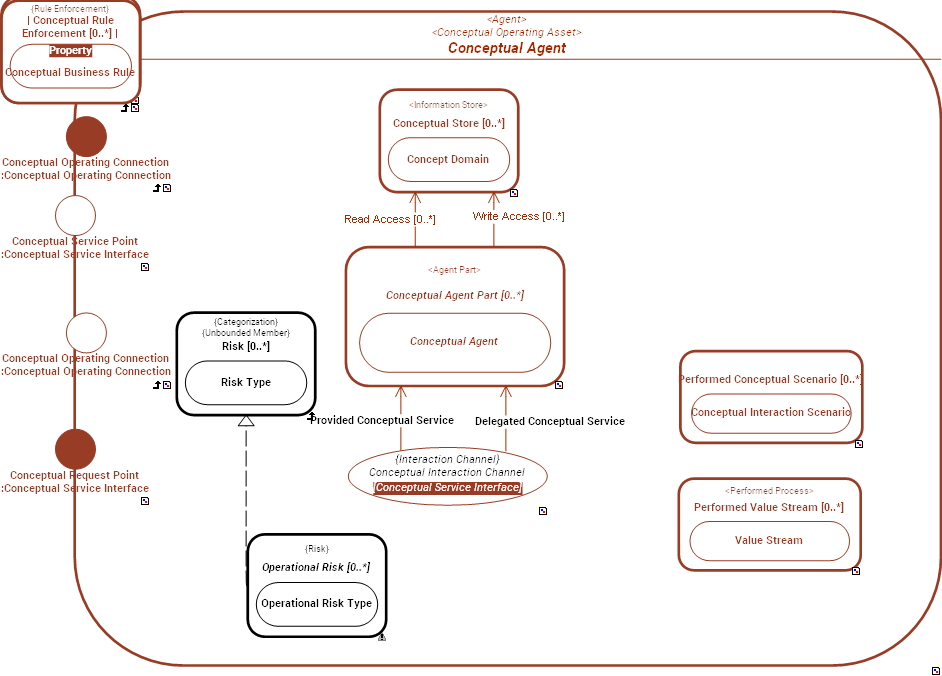BUILDING BLOCK - Conceptual Agent
| Description | Abstract Concept A Conceptual Agent is an abstract type of Agent that depicts a functional division of labor within an enterprise, influencing the formation of its business operating model. The concrete specializations of Conceptual Agent follow the systemic level pattern and come in the form of Operating Domain (a Macro Conceptual Agent) and Business Function (a Mezzo Conceptual Agent). Systemic Levels of Conceptual Agent: a Conceptual Agent is either a Business Function or an Operating Domain |
|---|---|
| External references |
 Christensen Institute - Modularity, Christensen Institute - Modularity,
 OMG - UAF - OperationalAgent, OMG - UAF - OperationalAgent,
 OpenGroup - ArchiMate - Business Internal Active Structure Element, OpenGroup - ArchiMate - Business Internal Active Structure Element,
 Russell Ackoff - System of concepts - FunctionalDivisionOfLabor Russell Ackoff - System of concepts - FunctionalDivisionOfLabor |
| Super Types |  Agent (from partition:
Conceptualization Levels of Agent)
Agent (from partition:
Conceptualization Levels of Agent)  Conceptual Operating Asset (from partition:
Structural Partition of Conceptual Operating Asset)
Conceptual Operating Asset (from partition:
Structural Partition of Conceptual Operating Asset) |
| Functional Domain |  Conceptual Operating Model
Conceptual Operating ModelA Conceptual Operating Model serves as a strategic framework for the enterprise, directing its functional division of labor to fulfill its missions and purposes. |
| Dictionary |  Dictionary of SysFEAT concepts
Dictionary of SysFEAT concepts |
| Conceptualization Levels |  Conceptual
Conceptual |
| Lexical Scope |  Architecture Container
Architecture Container |
| Framework Mapping |
UAF - Resource Views : OperationalAgent UAF - Security Views : OperationalAgent UAF - Strategy : OperationalAgent UAF - Resource Views : OperationalAgent |
RELATIONSHIPS
Simple Graph Graph & Inheritance Table
Simple Graph
Composition: ➝ Classification: ➝ Specialization: ➝ Enumerated definition: ➝ Syntax: ➝
TEXTUAL SYNTAX
SEMANTIC TAXONOMY
Sub-Types Super-Types
Click node rectangle to collapse/expand one level. Click triangle for full recursive collapse/expand. Double-click on a node to open its URL. Hover for description.
BORDERS
INTERNAL STRUCTURE

CONNECTORS
| Connector | Source | Target | Connector Type | Description |
|---|---|---|---|---|
 Conceptual Interaction Channel Conceptual Interaction Channel |
 Conceptual Agent Part.
Conceptual Agent Part. Conceptual Request Point
Conceptual Request Point |
 Conceptual Agent Part.
Conceptual Agent Part. Conceptual Service Point
Conceptual Service Point |
 Conceptual Service Interface
Conceptual Service Interface |
Abstract Connection An Interaction represents a contract between entities in a specific context inside or outside a company. These entities can be organizational units, activities, or processes. The content of this contract is described in a protocol. |